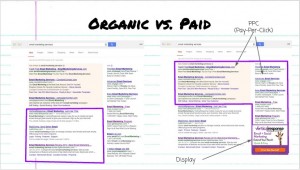Content is what makes a digital transformation run, so telling a story across all channels that is clear and consistent is more important than ever.
You must feed digital transformation or it dies. Once you’ve gone through the Herculean work of integrating the tech stack, designing and developing great new experiences, and shifting the processes and culture of the organization, it’s time to make that sleek new high-performance machine move as the salesperson promised.
So, you’ve got to fuel it, and that fuel is content. After all, how do you create a continuum of experience across all customer touchpoints without the content to fill that continuum? Where do you get the data to create a detailed picture of your customer if not through the content they access (or the content they ignore)? How do you maintain relevancy in the two most important digital channels, search and social, without content?
A digitally transformed organization is a content organization. With that much content, telling a disciplined story that is clear and consistent is more important than ever because the alternative is a big, blatant mess of a brand and an incomplete pool of data.
Your story moves at the speed of digital
Keeping a story accurate and consistent across a sales force and an ever-growing array of marketing channels has always been difficult. But digital transformation drastically changes the scale of both delivery and consumption.
Now, your story is going out; not just at the rhythm of a campaign, but continually across your marketing channels. Your social feeds are voracious, thought leadership constantly sought after in complex and changing industries, and you’re launching new experiences to stay competitive. And just as fast as it’s being delivered, it’s being consumed. To be top of mind with a customer is to be on top of your content game.
As your story goes out across all those channels at velocity, it’s also going out in numerous forms, from the few characters of a tweet to the pervasive language of an interface (yes, even your interface is telling a story) to the conversational interaction of your talking head videos. You need to ensure that your story not only can be adapted to those forms but that it is being done so appropriately all the time.
Finally, while your story is everywhere and moving at the speed of digital, so is everybody else’s. Your story needs to cut across the cacophony of competitor noise and the general digital deluge of information and experiences that your clients always face. That takes the continual distribution of an exactingly created, consistent story.
Your story is getting personal
Not only is the story spreading across more channels faster and more often, that story will probably have multiple versions. Digitally transformed companies are now set up to deliver and capitalize on personalized content, so a story needs to be more than just broadly relevant to a market and a field. It needs to speak directly to an audience segment and, more often than not, to a specific individual.
And even though these individuals and segments often differ in their challenges and how your organization can solve these problems for them, those messages cannot be at odds with each other. Those messages all need to serve the same brand with those individuals and segments being characters in a bigger, unified story. Otherwise, there will be confusion about your goals and priorities both externally in the market and internally in your organization.
Your story is speaking for itself
Today, your customer is steps ahead of your sales force. They’ve Googled your company, they’ve checked your website, they’ve read your social media feeds, they’ve reached out to colleagues across their social networks.
They’re halfway through the book before your sales representative even has a chance to set up the story with them face-to-face.
Your story is going to be self-driven, so wherever it appears, it needs to be simple and clear, regardless of the complexity of your solution, the complexity of your organization, and the complexity of your market. Even as your story gets more complex internally, as it versions for different audiences and different media, the outcome of that story, the part that your audience sees and interacts with, still needs to be simple and clear.
Your story changes based on the data
You should be telling your story over and over and over until your audience is so familiar with it, they can pitch it back at you. However, there is one important exception: if your story isn’t working. The most disciplined, consistent, and clear story might be inherently flawed. It happens. Erroneous assumptions, bad generalizations, a misunderstanding of the customer challenges, a misreading of the data, a misprediction of the trends — all of that can innocently make it into a story.
But the beauty of storytelling for a digitally transformed organization is that you’re going to know relatively quickly if it’s not resonating. It’s the same principle of a digitally transformed company quickly launching and adapting a product. That’s because you have a complete picture of your customer from data aggregation across channels.
In the past, you had the digital metrics to know that your white paper wasn’t being downloaded. You also know what your audience is searching for on Google thanks to AdWords and what they’re saying on social and through their content engines. But now those feeds are connected. The fundamental mandate of story writing is to know your audience. Digital transformation means you know more than analytics. You know the human beings behind those analytics.
And when you see that your story isn’t resonating and, more importantly, why it’s not resonating, you can change it. However, if even your erroneous story is not disciplined and clear, changing that story will be hard to do. Rebuilding a house on a badly built foundation is extremely difficult.
You are competing on the content experience
Anywhere you release a single sentence into the market, you face an opportunity to either strengthen your story or degrade it in public. With digital transformation, that opportunity is coming at you scores of times a day. The digitally transformed company is competing on its experiences, and that includes the content experience. Releasing undisciplined content across all of those many opportunities piles up and creates costly problems for the brand.
To ensure a high-quality content experience, you need to make sure there’s a story behind it, and that the story is accurate, consistent, tightly adaptable to both media and audience, and continually delivered. Being able to do that takes a lot of discipline in the marketing organization. And I mean a lot. It takes a process for creating the story. It takes an official, almost sacred, documentation for housing that story. It takes somebody in charge of that story at all times.
You must feed digital transformation or it dies. But you also must be careful what you feed it, else it can turn on you.
Opinions expressed in this article are those of the guest author and not necessarily Marketing Land. Staff authors are listed here.
Marketing Land – Internet Marketing News, Strategies & Tips
(26)







